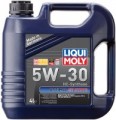SAE
The degree of oil viscosity, determined according to the international SAE standard. Viscosity is one of the key physical characteristics of an oil that determines its compatibility with a particular engine. Most modern brands of oil are all-weather and are designed for use, incl. and at low temperatures. Therefore, the SAE index for them includes information not only on the viscosity characteristics in a warm engine, but also on frost resistance.
Such an index is usually written in the form of two digits separated by the letter w:
0w-8,
0w-12,
0w-15,
0w-16,
0w-20,
0w-30,
0w-40,
0w-50,
5w-20,
5w -30,
5w-40,
5w-50,
5w-60,
10w-30,
10w-40,
10w-50,
10w-60,
15w-40,
15w-50,
15w-60,
20w-20,
20w-50,
20w-60,
...25w-40. There is also the format SAE 10w, SAE 20, SAE 30, SAE 40 and SAE 50. The first number describes only the cold resistance of the oil, and does not apply to its properties when the engine is warm. If 35 is subtracted from this number, you get the minimum temperature at which the engine can be cranked over to start. In our example, this temperature will be 15-35=-20 °C. Of course, such values are rather arbitrary, because In practice, other factors must also be taken into account. For example, with a “dead” battery (which is not uncommon in cold weather), a cold start can cause difficulties even at a higher temperature than follows from the characteristics of the oil.
The second number determines the characteristics of the oil in a warm engine in normal mode, at normal operating temperatures. It is this indicator that is the main one for choosing a brand of lubricant for a particular car - you must strictly adhere to the manufacturer's recommendations. The fact is that each engine is designed based on strictly defined viscosity values. An oil that is too viscous will linger in large quantities in moving parts, and one that is too fluid will leave them without lubrication at all; In both cases, power drops and wear increases. Therefore, first of all, when choosing according to SAE, the second number and its correspondence to the characteristics of the engine should be taken into account.Porsche approvals
An engine oil quality standard that Porsche considers essential for correct operation when used in the engine of its vehicles. For various engines (respectively, car brands) there is a standard, among which are
A40,
C20,
C30 and
C40.
BMW, MINI approvals
An engine oil quality standard that BMW considers essential for correct operation when used in the engine of its vehicles. For various engines (respectively, car brands) there is a standard, among which are
Longlife-98,
Longlife-01,
Longlife-04,
Longlife-12 FE,
Longlife-14 FE + and
Longlife-17 FE +.
Approvals Mercedes-Benz
An engine oil quality standard that Mercedes-Benz considers essential for correct operation when used in the engine of its vehicles. For different engines (respectively, car marks) provides its standard, among which there are
226.5,
226.51,
226.9,
228.5,
229.3,
229.5,
229.5,
229.5, 229.5, 229.5,
229.7,
229.5,
229.5,
229.5,
229.3,
229.5,
229.31 , 229.5Renault approvals
An engine oil quality standard that Renault considers essential for correct operation when used in the engine of its vehicles. For various engines (respectively, car brands) there is a standard, among which are
AN2022,
RN 0700,
RN 0710,
RN 0720,
RD,
RD-2,
RGD,
RLD,
RLD-2,
RLD-3,
RLD-4,
RLS-3,
RVI and
RXD.

